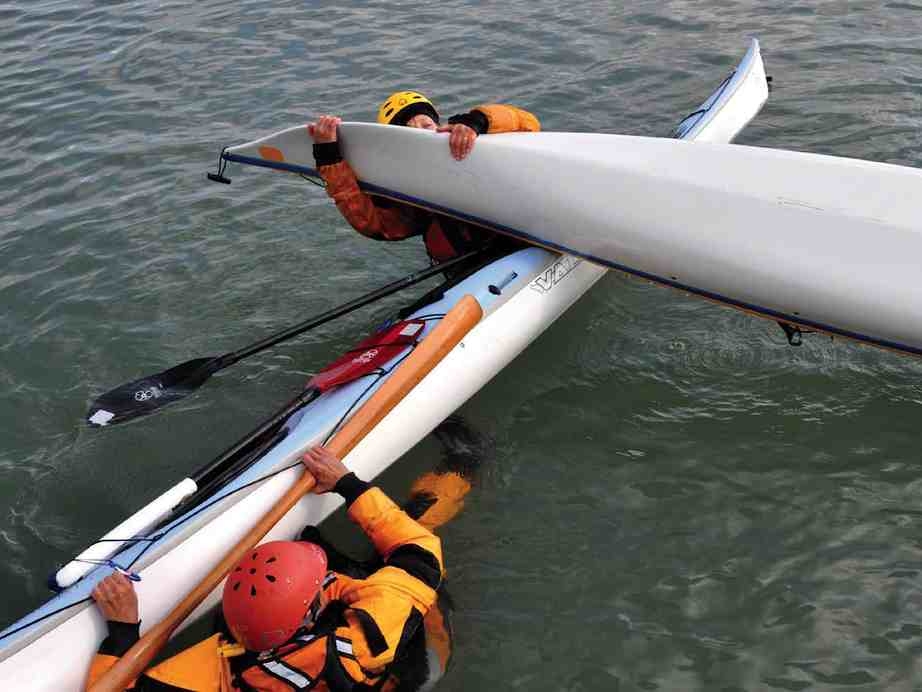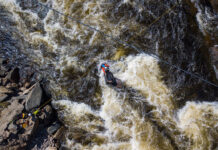The T-rescue is the workhorse assisted rescue for sea kayakers. Done properly, it enables you to quickly get a capsized paddler back into a dry boat in any conditions.
In recent years, old techniques have been replaced, such as having the swimmer hold and push down onto the stern of their kayak. Some have been added, such as the heel-hook reentry. Others are specific to sea conditions and paddler skill. But despite the variations, there are a few keys to efficient, effective T-rescues in every situation.

Step-by-step T-rescue kayak technique
1 Don’t rush in
Take a moment to communicate and ensure she isn’t too panicky to cooperate. Remind her to hold onto her boat and paddle.
2 Flip the boat
Ask her to flip her boat, if possible, and slide to the bow. Then paddle up to her bow.
3 Transfer the capsized paddler
Have the capsized paddler transfer to your boat, preferably close to your cockpit unless conditions dictate otherwise. Don’t let her swim; remind her to hold onto the deck lines of both boats while making the transfer. Then swing her boat into the T position (bow facing your cockpit) by leaning on her boat and spinning it.
4 Slide the boat up on your spray deck
Bring the bow a foot or two past the far side of your boat so that the cockpit will clear the water when you flip it. Tip her boat toward you to begin emptying the cockpit, then flip it all the way upside-down. Instead of lifting the boat, grip it and edge your own boat away. You’ll be completely stable because her boat will act as a huge pontoon, and you’ll avoid straining your shoulders. Stay in this position until the cockpit is empty and you’ve flipped the boat right-side-up again. Slide the boat back into the water.
5 Position the boat for reentry
Maneuver the capsized boat until the stern is pointing toward your bow. Using the deck lines, slide the boat along to make it easy for the swimmer to transfer from your boat to hers without letting go of the deck lines. Then push the boat toward her as she walks her hands along the deck lines and arrives at the cockpit.
6 Capsized paddler reenters boat
How the swimmer re-enters is up to individual preference and conditions. Some people prefer a scramble re-entry, while others prefer a crab or heel-hook. Regardless, remind her to stretch out so that her center of gravity remains low. To secure her boat, grab the deck lines in front of her cockpit, wrap your body over her deck and hold tightly. If you hold the coaming, your fingers may get kicked or pinched, and you’ll have to transfer your hands to the deck lines so she can secure her spray skirt, providing a moment of instability. Remain in this position until her spray deck is on, she’s holding her paddle and she says she’s ready. Then slide gently away.
The main points here are ensuring that both people keep hold of the boats at all times, sliding boats instead of moving the swimmer, edging instead of lifting the capsized boat, and stabilizing the emptied boat by draping your body instead of using upper-body strength. These approaches facilitate a faster and safer rescue by enabling you to get into position quickly and use technique instead of strength.
Practice often in many conditions, with different swimmers and rescuers, and using various re-entry techniques. That way, you’ll have experience to draw upon when you really need to use the T-rescue.
Sharon and Alec Bloyd-Peshkin (www.bloyd-peshkin.blogspot.com) are ACA Level 4 sea kayak instructors and BCU Level 1 coaches at Geneva Kayak Center in Chicago.
This article was first published in the Spring 2010 issue of Adventure Kayak Magazine. Subscribe to Paddling Magazine’s print and digital editions, or browse the archives.
Performing a T-rescue. | Feature photo: Sharon and Alec Bloyd-Peshkin








